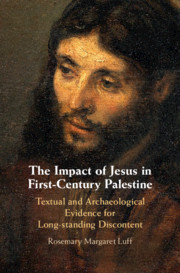 The Impact of Jesus in First-Century Palestine
The Impact of Jesus in First-Century Palestine from Part I - Memories of Jesus: The Textual Evidence
Published online by Cambridge University Press: 26 July 2019
The strong eschatological vein portrayed in Jesus’ teaching raises questions concerning the nature and degree of instability being experienced by the inhabitants of Galilee and Judea. This chapter evaluates the documentary evidence for discontent at the time of Jesus, against a backdrop of foreign invasions and conquests over five hundred years. There is substantial evidence that there was discontent among the people: the cumulative evidence from Josephus, the Dead Sea Scrolls, certain apocalypses, and the Evangelists, especially the literarily distinct Gospels of Mark and John, supports this. After the Feeding of the Five Thousand clearly a large crowd wanted Jesus as their leader, even their king, and tried to coerce him into this, but he was not interested. His focus was on God and the implementation of his kingdom through discipleship. As an apocalyptical and eschatological prophet Jesus believed that God’s rule was in the process of happening, and he is remembered as warning about judgement to come for the unrepentant. His ministry centred on the welfare of the poor, and their inclusion in the coming kingdom.
To save this book to your Kindle, first ensure [email protected] is added to your Approved Personal Document E-mail List under your Personal Document Settings on the Manage Your Content and Devices page of your Amazon account. Then enter the ‘name’ part of your Kindle email address below. Find out more about saving to your Kindle.
Note you can select to save to either the @free.kindle.com or @kindle.com variations. ‘@free.kindle.com’ emails are free but can only be saved to your device when it is connected to wi-fi. ‘@kindle.com’ emails can be delivered even when you are not connected to wi-fi, but note that service fees apply.
Find out more about the Kindle Personal Document Service.
To save content items to your account, please confirm that you agree to abide by our usage policies. If this is the first time you use this feature, you will be asked to authorise Cambridge Core to connect with your account. Find out more about saving content to Dropbox.
To save content items to your account, please confirm that you agree to abide by our usage policies. If this is the first time you use this feature, you will be asked to authorise Cambridge Core to connect with your account. Find out more about saving content to Google Drive.